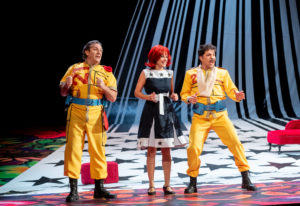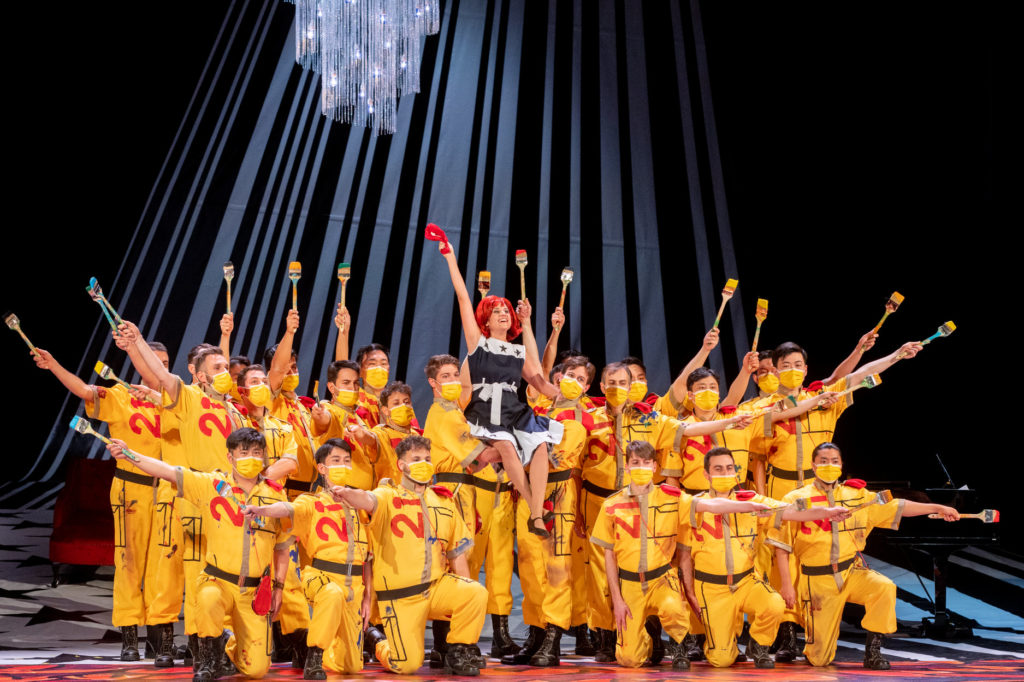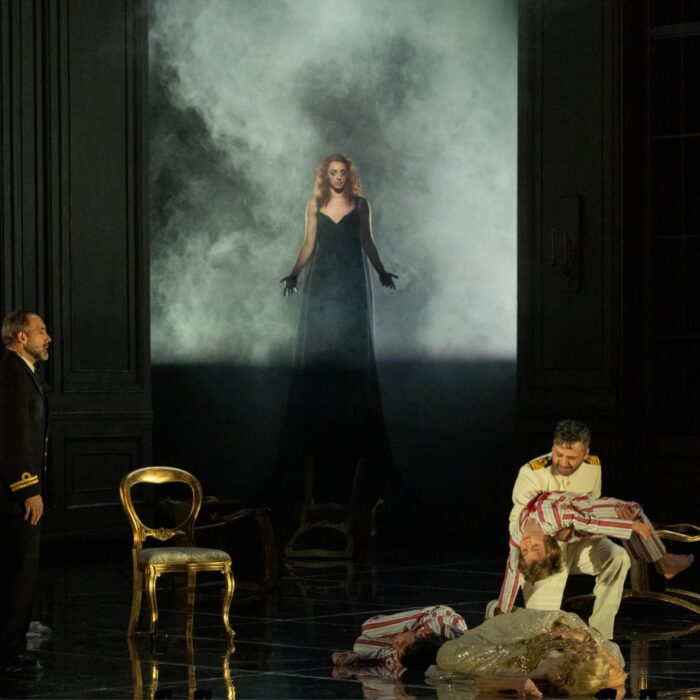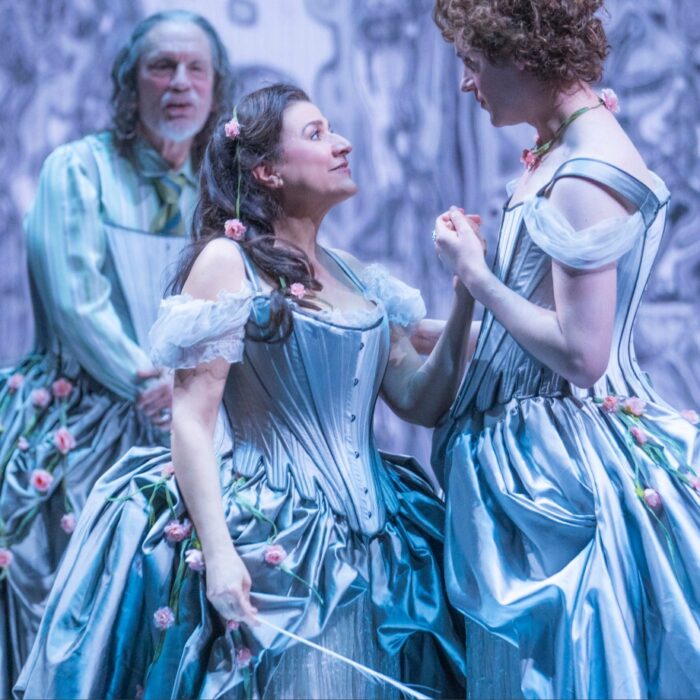
Donizetti Opera Festival 2021 Review: La Fille du Regiment
Sarah Blanch & John Osborn Lead an Outstanding New Production of Donizetti’s Comedy
By Mauricio VillaOn Nov. 21, the Donizetti Opera Festival opened a production of “La Fille du Regiment” in a co-production with the Teatro Nacional de Cuba. The result was a colorful show with an incredible cast taking on a new critical edition of the score.
The audience approved.
A Colorful Production
The stage director Luis Ernesto Doñas set the opera in Cuba and featured sets inspired by the artwork of Cuban painter Raul Martínez, who was committed to the Cuban Revolution. As a result, the production turned Tonio into an American “Yankee” and the Marquise de Berkenfield was surrounded by a Black and White version of the United States flag. Despite these political references, the production turns the regiment into a bunch of painters who carry paintbrushes instead of guns and who moved and danced in a colorful art-deco forest inspired by the artwork of Martinez.
Doñas also included some Latin rhythms into the score, and there were even some Spanish jokes and sentences. While this approach takes the action out of the original setting, which takes place in Tyrol at the camp of a French army, the concept works extremely well and creates a lively amusing production that entertained the audience.
An interesting touch to the evening was that thirty minutes before the opera began, there were actors and musicians playing Latin drum rhythms and dancers dancing a classical waltz at the front entrance of the Teatro Donizetti. This allowed audiences to immerse themselves into the conflict between the lively low class and the world of the aristocracy which was more conventional and rigid. At the end of the performance, a painting of Martínez was projected on the façade of the theater.
An Impeccable Cast
The Spanish soprano Sara Blanch portrayed Marie, the daughter of the regiment. She has a bright lirico-leggera voice with a crystalline timbre and round projected high notes. During the evening, her stamina and breath control were put to test in a frenzied physical staging. Yet she was up to the challenge as she sang with supported legato lines and pitch-perfect staccato high notes. Her singing was particularly memorable during her “Chacun le sait” and her moving emotional “il faut partir.” However, it was the “lesson scene” in Act two that was the highlight of her performance. It was incredible how well Blanch managed to fake bad singing by emitting flat plain tones but then quickly switched to singing difficult coloratura scales that rose to B naturals.
During the second act aria “Par le rang et par l’opulence,” she once again demonstrated her refined legato singing with a beautiful mezza voce and respected the written cadenzas. During cabaletta, “Salut a la France,” Blanch dispatched the vocal pyrotechnics with fast scales, staccato high notes, and a final ringing E flat while being held by the male chorus. She was funny and full of energy but above all, her characterization of Marie was believable and that moved the audience.

American tenor John Osborn sang the role of Tonio and during the evening gave audiences a treat by encoring the famed aria “A mes Amis.” The aria is known for its 9 high Cs and is a test for any tenor. On this evening Osborn, who has easy extreme high notes, dispatched the aria with flexibility and vocal fireworks. At one point he even added two short high Cs in the phrase “Jour prospére! Me voici, mlitaire et Marie.” Then on the second round of high Cs, he added an appoggiatura that went up to a high D. On the final High C, he shortened his breath in order to sing a second high C on the phrase “Militaire et Marie.” By the end of the aria, Osborn had sung 12 high Cs instead of the original 9. When he concluded the piece, he was rewarded with an ovation of “bravos” and endless applause. The audience eventually started shouting “bis.” Osborn looked at conductor Michele Spotti and both agreed to do the aria again. In his second rendition, Osborn’s singing was effortless and he transmitted pure joy.
But Osborn’s performance was not limited to this showcase of high notes and vocal pyrotechnics. Throughout the evening the tenor brought impeccable phrasing and great musicality. In his second aria, “Pour me rapprocher de Marie,” the tenor displayed elegant crescendos and diminuendos that made his singing filled with sweetness. There was also great breath control and vocal flexibility that allowed him to show a great variety of dynamics throughout his whole range, including the passagio and the high register. The festival was using the critical edition of the score and as a result, the aria is one semi-tone higher. The aria, therefore, demands the tenor to sing several high B flats and a high C during extended long legato phrases. There is also a new cadenza that includes two high Ds and two high Cs and as if the aria didn’t have enough high notes, Osborn interpolated an incredible high E flat in the final cadenza. With a diverse array of colors and expressivity, this was by far the highlight of his performance.
The buffo baritone Paolo Bordogna portrayed the role of Sulpice and gave an amusing and truthful interpretation. He was funny but not clownish and therefore gave dignity to the short but important role. He avoided all comical cliches and sang with a strong round sound and got a chance to sing a sustained well-projected high G at the end of his duet with Marie in the first act.
The Gabon mezzo-soprano Adriana Bignagni Lesca portrayed the role of la Marquise de Berkenfield with an astonishing thunderous low register that sounded like a contralto. In Act two she sang a beautiful “Habanera” from “Carmen,” displaying her velvety dark sound and giving more vocal presence to the role.
The Young Italian conductor Michele Spotti chose fast tempi throughout the evening obtaining a strong sound from the orchestra. His conducting was energetic and lively and it gave a freshness to the score. He was also always aware of the singer’s needs and as a result, the soloists and the orchestra were in unison during the entire performance. The “Coro dell’Accademia Teatro alla Scala” sounded strong and youthful giving energy to the production.
Overall this new production to Donizetti’s famous comic opera greatly entertained the audience and the splendid cast only added to an unforgettable evening. This was without a doubt the best production of the 2021 festival.


